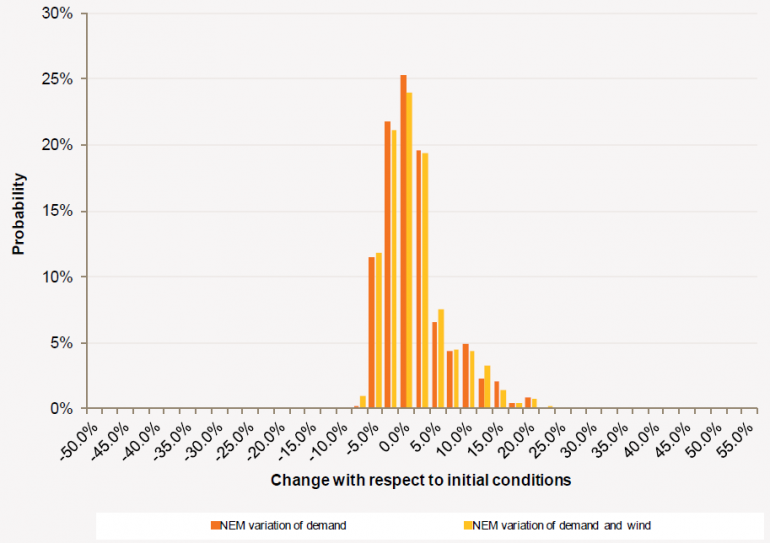King's convenient wind ignorance
Yesterday I observed how humans have an inherent tendency to overlook or forget the imperfections and challenges associated with the status quo because we’ve got used to working around them. Meanwhile anything new is examined very critically and any shortfalls are seen in isolation from the flaws and difficulties associated with the existing system.
I related this to the story of how the Queensland Competition Authority has viewed the proliferation of solar as a free riding anomaly, when in fact it is the model of charging households the same price for electricity no matter the time or location which is the major problem.
Today I’d like to extend this to the myriad of criticism we hear about wind power, most recently from Grant King, CEO of Origin Energy.
In his CEDA speech on March 18, Grant King made a number of statements that sought to promote this idea of large hidden costs associated with the Renewable Energy Target that are worthy of further scrutiny.
But for the purposes of today’s column let’s focus on one statement he made:
“So this investment in RET-driven renewables, which is largely satisfied by wind, will drive increasing volatility and potentially increasing unreliability in the NEM unless, of course, that power is firmed and most likely firmed by open cycle gas to provide us with the reliability, but of course, at an additional cost, a cost greater than the actual cost of the wind itself.”
This is a familiar argument put forward by critics of wind power to suggest that it imposes challenges that are unprecedented and unmanageable. This argument generally goes along the following lines:
1) Show graph of wind output changing substantially over time to get people to think about how incredibly unreliable it must be.
2) Suggest this means wind must be backed-up one for one with additional and highly expensive gas peakers. Therefore, on top of the cost of generating electricity from wind, you must add the cost of generating power from a gas peaker.
This approach conveniently ignores the reality that gas peakers and other fast response and reserve capacity are required even with no wind power due to:
1) The substantial inherent variation in electricity demand including the fact that there are large but short duration peaks in demand; and
2) Unplanned break-down of electricity generators.
Because of these two inherent features of electricity systems we must have quite a large amount of generating capacity that lies idle much of the time, irrespective of whether we add wind power to the system.
So in determining the system management costs associated with wind you can’t just look at the extent to which it might vary in isolation, but rather the extent to which its variance makes a difference to cost of managing the variance of the system as a whole.
To illustrate let me give you an example from just a few days ago on March 21.
In the five minute interval beginning at 6:55am the price of electricity in Queensland was $70 per megawatt-hour. In the next five minute interval it was $8500 per MWh and then it was back down to $60 in the five minutes after that as if nothing untoward had happened. The reason for this sudden volatility according to Australian Energy Market Operator was, “a significant (though not unusual) demand change” where demand surged upwards by 173MW within five minutes which hadn’t been predicted.
So the issue is not whether wind varies full stop, so much as the extent to which its variance makes the system harder to keep in balance than what’s already the case.
As it happens AEMO and CSIRO have already simulated the likely additional variance beyond that associated with underlying electricity demand, due to the Renewable Energy Target supporting 8200MW of wind power in the NEM. In discussing the results, illustrated in the chart below, AEMO observed:
“The NEM-wide hourly variability of wind in combination with demand is not significantly different from the variability of demand alone. Therefore, if hourly changes in wind demand can be accurately predicted, and in the absence of network limitations, this variability should not add significantly to the difficulty of NEM-wide power system management.”
NEM hourly variation of demand with and without 8200MW of wind

Source: AEMO (2011) National Transmission Network Development Plan 2011. Based on hourly wind data for 148 locations across the NEM using historical wind data from the period 1 January 2002 to 1 January 2011, for a hub height of 60 metres.
Now this should not be interpreted to mean that wind will not impose additional system management requirements as wind expands fourfold from the current 2000 megawatts already in operation. But this suggestion that for every unit of additional wind generation you have to add the cost of power from an open-cycle gas turbine is unadulterated rubbish.
The extra cost was actually modelled in quite a degree of detail by ROAM Consulting for the Australian Energy Market Commission. In its case ROAM looked at a little under 8000MW of wind in the NEM. The extra cost of managing the variability of wind worked out at $6-$8 per MWh generated by wind – an awfully long way from King’s suggestion of a “cost greater than the actual cost of the wind itself”.
What’s more, the author of the study, Jenny Riesz, explained to me that the study used conservative assumptions that most likely overstate these system management costs.
















